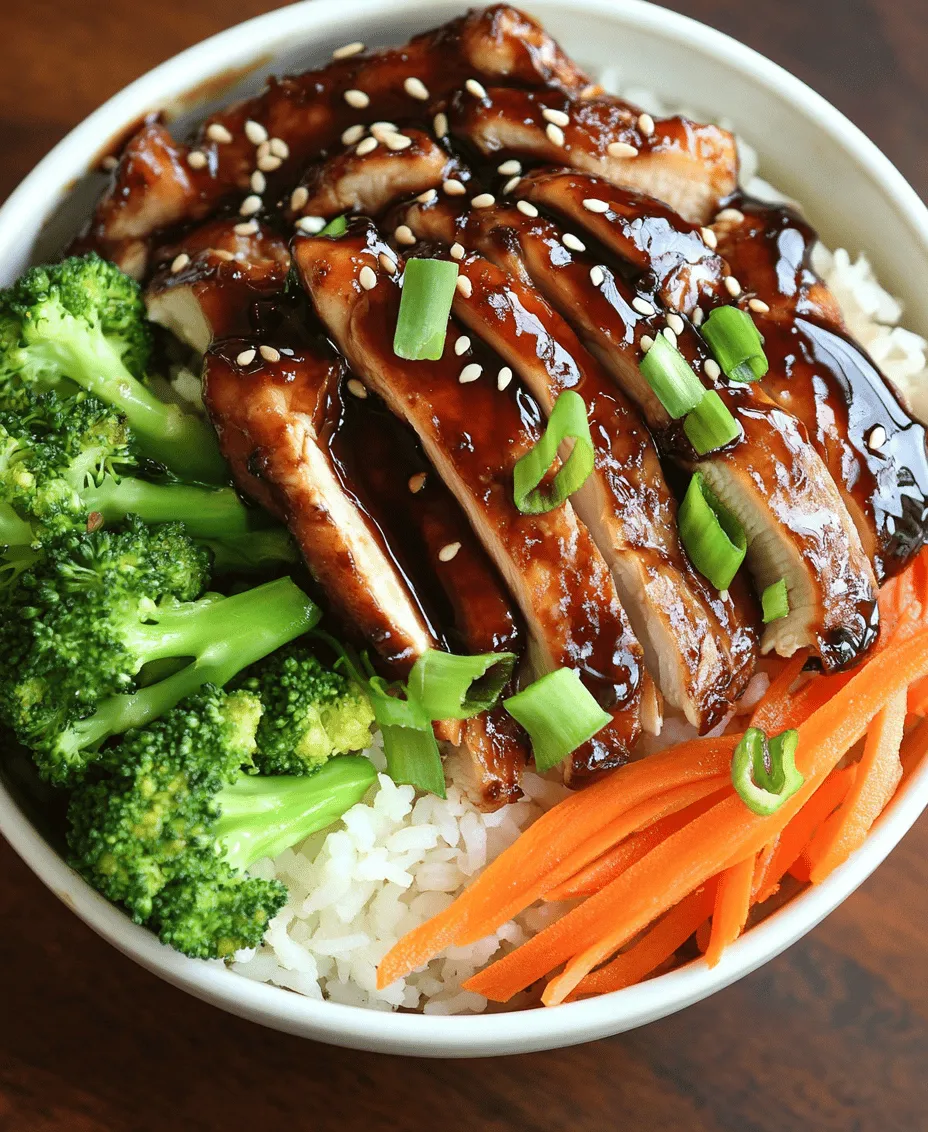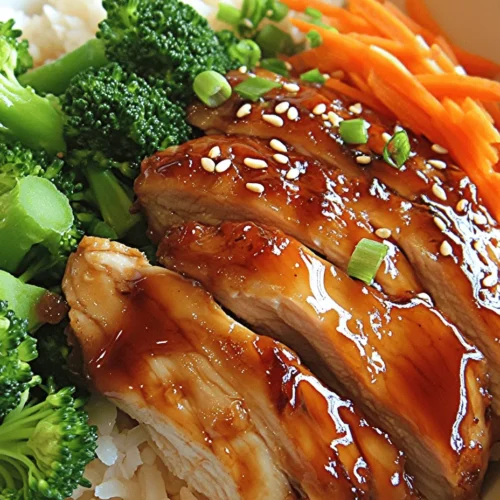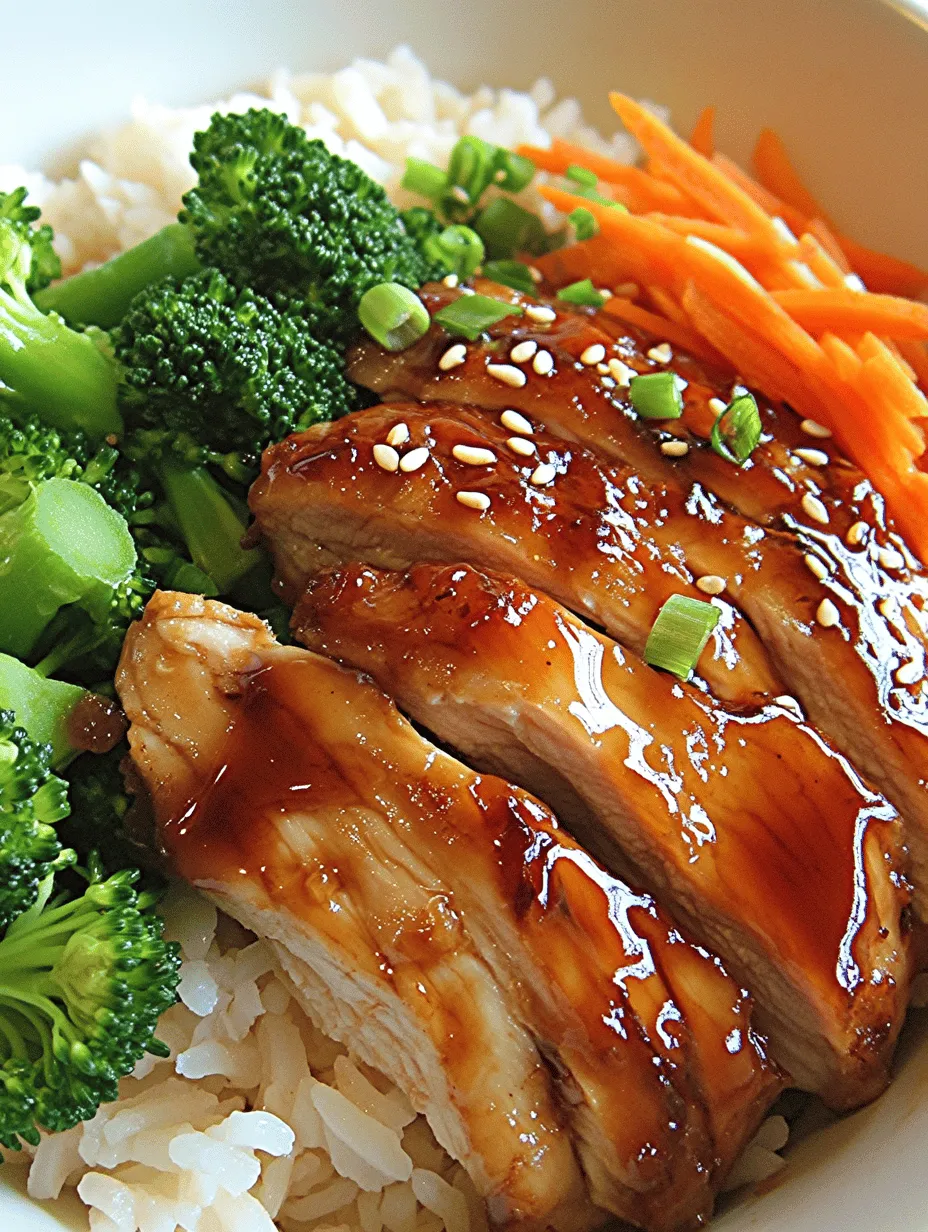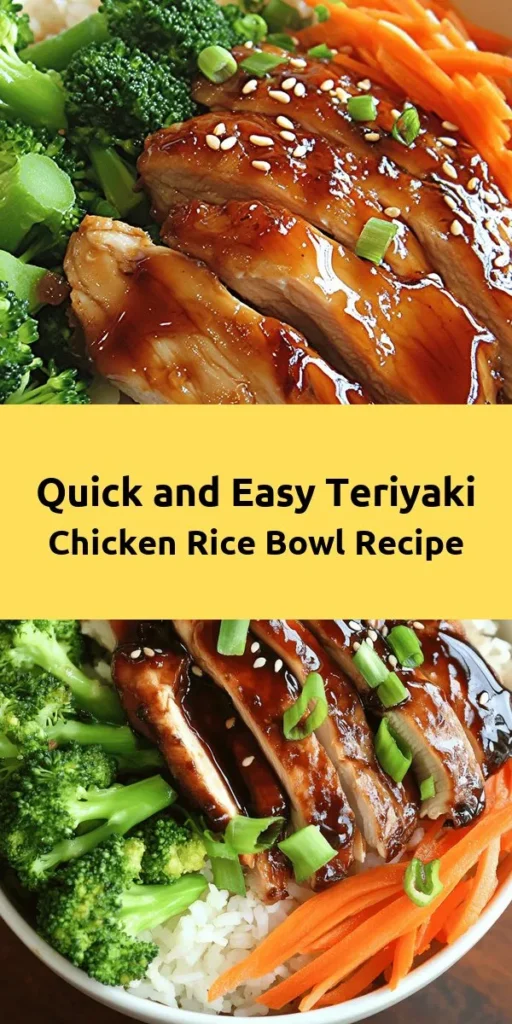Introduction
Asian cuisine is celebrated worldwide for its rich flavors, intricate techniques, and vibrant presentations. Among the myriad of dishes that grace the tables of homes and restaurants alike, the Teriyaki Chicken Rice Bowl stands out as a harmonious blend of savory flavors, tender chicken, and vibrant vegetables, all atop a bed of fluffy jasmine rice. This dish not only tantalizes the taste buds but also provides a balance of nutrition and satisfaction, making it a perfect weeknight dinner or meal prep option.
The Teriyaki Chicken Rice Bowl is more than just an assembly of ingredients; it is a culinary experience rooted in tradition. The combination of succulent chicken, a glossy teriyaki glaze, and a variety of colorful vegetables creates a visually appealing and deliciously satisfying meal. In this article, we will delve into the step-by-step process of creating this delectable dish while exploring the history and cultural significance of teriyaki, the nutritional benefits of the ingredients, and tips to customize your bowl.
The Origin of Teriyaki and Its Cultural Significance
Exploring the History of Teriyaki as a Cooking Technique
Teriyaki, which translates to “grilled” or “broiled” in Japanese, represents a cooking style that encompasses both the method of preparation and the sweet-savory glaze that accompanies it. The technique dates back to the Edo period (1603-1868) in Japan, where fish and meat were marinated in soy sauce, mirin, and sake, then grilled or broiled to perfection. The term “teriyaki” itself is derived from “teri” (meaning glaze) and “yaki” (meaning to grill or broil), highlighting the emphasis on achieving a beautifully caramelized exterior.
Understanding the Cultural Roots of Teriyaki in Japanese Cuisine
In Japanese culture, teriyaki is deeply intertwined with the principles of balance and harmony. The flavors of sweet and savory are carefully balanced, reflecting the Japanese culinary philosophy of umami, the fifth taste that enhances the overall flavor profile of a dish. Traditionally, teriyaki was used for fish, particularly in coastal regions, but over time, chicken and beef became popular choices for this cooking technique. The dish is often enjoyed during special occasions and family gatherings, showcasing the importance of food in Japanese hospitality.
The Evolution of Teriyaki in Western Culinary Practices
As Japanese cuisine gained popularity in the West during the late 20th century, teriyaki underwent a transformation. It became a staple in many Asian fusion restaurants and home kitchens, often adapting to local tastes and ingredient availability. Western iterations of teriyaki frequently feature a thicker, sweeter sauce and are commonly served with rice and vegetables, making it a convenient and flavorful option for busy families. Today, the Teriyaki Chicken Rice Bowl is celebrated not just as a Japanese dish but as a beloved comfort food enjoyed by many around the globe.
Ingredients Breakdown: What Makes This Teriyaki Chicken Rice Bowl Special?
To create an unforgettable Teriyaki Chicken Rice Bowl, understanding the ingredients is essential. Each component not only contributes to the dish’s flavor and texture but also offers nutritional benefits.
Overview of the Core Ingredients
1. Boneless, Skinless Chicken Thighs: The star of the dish, chicken thighs are known for their tenderness and flavor. They remain juicy during cooking, making them ideal for the teriyaki glaze.
2. Jasmine Rice: This fragrant rice variety is a staple in Asian cuisine. Its slightly sticky texture makes it perfect for holding onto the teriyaki sauce and creating a satisfying base for the bowl.
3. Soy Sauce: A fundamental ingredient in teriyaki sauce, soy sauce provides the dish with its signature umami flavor. It is made from fermented soybeans, giving it a complex taste.
4. Garlic and Ginger: These aromatic ingredients add depth to the teriyaki sauce, enhancing the overall flavor profile with their pungent and warming characteristics.
5. Sweeteners: Typically, honey or brown sugar is used to balance the savory notes of soy sauce, adding a touch of sweetness that caramelizes beautifully during cooking.
6. Vegetables: Fresh broccoli and carrots are commonly included for their vibrant colors and crunch, adding nutritional value and a fresh contrast to the rich chicken and sauce.
7. Garnishes: Green onions and sesame seeds not only elevate the presentation of the dish but also contribute additional layers of flavor and texture.
Nutritional Benefits of Boneless, Skinless Chicken Thighs
Boneless, skinless chicken thighs are an excellent source of protein, making them a nutritious choice for those looking to maintain a balanced diet. They contain essential amino acids necessary for muscle repair and growth, while being lower in fat compared to other cuts of chicken, such as wings or drumsticks. Additionally, chicken thighs are rich in important vitamins and minerals, including B vitamins (which aid in energy metabolism) and selenium (a powerful antioxidant).
The Role of Jasmine Rice in Asian Cuisine
Jasmine rice, native to Thailand, is renowned for its delicate floral aroma and slightly sticky texture when cooked. This rice variety is a staple in many Asian dishes, complementing a wide range of flavors. Not only does jasmine rice provide a satisfying base for the teriyaki chicken, but it is also a source of carbohydrates, which are essential for energy. Its low to medium glycemic index makes it a preferable option for those seeking a healthier carb source compared to white rice.
Exploring the Flavor Profile of Soy Sauce and Its Alternatives
Soy sauce is the cornerstone of teriyaki sauce, contributing a rich umami flavor that enhances the overall dish. However, for those with dietary restrictions or preferences, there are alternatives available. Tamari, a gluten-free soy sauce, can be used for those with gluten sensitivities, while coconut aminos offer a soy-free option with a slightly sweeter taste. Regardless of the choice, the sauce’s salty and savory characteristics are essential for achieving the authentic teriyaki flavor.
The Importance of Fresh Garlic and Ginger in Enhancing Flavor
Fresh garlic and ginger are indispensable in creating a well-rounded teriyaki sauce. Garlic adds a pungent kick, while ginger provides a warm, spicy note that brightens the overall flavor profile. Both ingredients are revered in Asian cooking for their health benefits, including anti-inflammatory properties and digestive support. Using fresh garlic and ginger instead of powdered versions will significantly elevate the flavor of your teriyaki chicken.
Comparing Honey and Brown Sugar as Sweeteners in Teriyaki Sauce
Sweetness is a crucial element in teriyaki sauce, balancing the saltiness of soy sauce and the heat of garlic and ginger. Honey and brown sugar are the most common sweeteners used, each bringing its unique characteristics to the dish. Honey offers a floral sweetness and a hint of complexity, while brown sugar, with its molasses content, provides a deeper, more caramel-like flavor. Depending on your preference, you can use one or the other to achieve the desired taste in your teriyaki sauce.
Health Benefits of Broccoli and Carrots: Nutrient-Packed Vegetables
Broccoli and carrots are not only colorful additions to the Teriyaki Chicken Rice Bowl but also powerhouses of nutrition. Broccoli is rich in vitamins C and K, fiber, and several antioxidants, supporting immune health and reducing inflammation. Carrots are an excellent source of beta-carotene, which the body converts into vitamin A, essential for eye health. Including these vegetables not only enhances the dish’s flavor and texture but also boosts its overall nutritional profile.
Garnishes: How Green Onions and Sesame Seeds Elevate the Dish
The finishing touches on your Teriyaki Chicken Rice Bowl can make a significant difference in both presentation and taste. Chopped green onions add a fresh, mild onion flavor and a pop of color, while toasted sesame seeds provide a nutty crunch. These garnishes not only enhance the visual appeal of the dish but also contribute additional layers of flavor that elevate the overall dining experience.
Step-by-Step Instructions to Create the Perfect Teriyaki Chicken Rice Bowl
Now that we’ve covered the enticing history and nutritional benefits of the ingredients, it’s time to dive into the practical aspects of creating this delicious Teriyaki Chicken Rice Bowl. Follow these detailed steps to ensure a mouthwatering result.
Cooking the Rice: Techniques for Perfect Jasmine Rice
1. Measure the Rice: Start by measuring out 1 cup of jasmine rice, which typically serves two people. Rinse the rice under cold water to remove excess starch, which helps achieve a fluffy texture.
2. Cooking Method: In a medium-sized pot, combine the rinsed rice with 1.5 cups of water and a pinch of salt. Bring the mixture to a boil over medium-high heat.
3. Simmer and Cover: Once boiling, reduce the heat to low, cover the pot with a lid, and let the rice simmer for about 15 minutes. Avoid lifting the lid during this time, as the steam is crucial for even cooking.
4. Fluff the Rice: After 15 minutes, remove the pot from heat and let it rest for an additional 5 minutes. Finally, use a fork to fluff the rice gently before serving. This will ensure a light and airy texture, perfect for absorbing the teriyaki sauce.
Preparing the Teriyaki Sauce: Achieving the Right Balance of Flavors
1. Combine Ingredients: In a small saucepan, combine 1/2 cup of soy sauce, 1/4 cup of honey (or brown sugar), 1 tablespoon of rice vinegar, 2 minced cloves of garlic, and 1 teaspoon of freshly grated ginger. Stir the mixture over medium heat until the sweetener dissolves completely.
2. Thicken the Sauce: To create a thicker teriyaki sauce, mix 1 tablespoon of cornstarch with 2 tablespoons of cold water in a small bowl to create a slurry. Gradually pour this mixture into the saucepan while stirring continuously. Allow the sauce to simmer for a few minutes until it thickens to your desired consistency.
3. Adjust Flavor: Taste the sauce and adjust the flavors as needed. If you prefer a sweeter sauce, add more honey or brown sugar. For additional depth, consider adding a splash of sesame oil or a pinch of red pepper flakes for a hint of heat.
With your jasmine rice cooked to perfection and your homemade teriyaki sauce ready, you are well on your way to assembling your Teriyaki Chicken Rice Bowl. Stay tuned for the next part of this article, where we will cover the preparation of the chicken and vegetables, as well as the final assembly of your delicious meal.

Cooking the Chicken: Tips for Perfectly Juicy and Flavorful Chicken
To create the perfect Teriyaki Chicken Rice Bowl, the chicken is undoubtedly the star of the show. Here are some tips to ensure your chicken remains juicy and packed with flavor.
1. Choosing the Right Cut: Opt for boneless, skinless chicken thighs for more flavor and moisture compared to chicken breasts. If you prefer breasts, be sure to marinate them longer to enhance their taste.
2. Marination Time: Allow the chicken to marinate in the Teriyaki sauce for at least 30 minutes. For the best results, marinate it overnight; this will intensify the flavor and tenderness.
3. Cooking Methods: You can grill, pan-fry, or bake the chicken. Grilling gives a lovely smoky flavor, while pan-frying offers a crispy texture. If you choose to bake, ensure the chicken is cooked through and reaches an internal temperature of 165°F (75°C).
4. Avoid Overcooking: Monitor the cooking time closely. Overcooking will result in dry chicken. Use a meat thermometer to check for doneness, and let the chicken rest for a few minutes post-cooking to allow the juices to redistribute.
Thickening the Sauce: When and How to Use Cornstarch
Once your chicken is cooked, it’s time to prepare the sauce. If you prefer a thicker sauce that clings beautifully to the chicken and rice, cornstarch is your best friend.
1. Cornstarch Slurry: Mix equal parts of cornstarch and cold water in a small bowl to create a slurry. This is typically about 1 tablespoon of each for a medium-sized batch of sauce.
2. Incorporating the Slurry: Once the chicken is cooked and removed from the skillet, add the remaining teriyaki sauce to the pan. Bring it to a simmer and then slowly whisk in the cornstarch slurry.
3. Cooking Time: Allow the sauce to simmer for an additional 2-3 minutes, stirring constantly until it thickens. You’ll know it’s ready when it coats the back of a spoon.
Steaming the Vegetables: Preserving Color and Nutrients
Fresh vegetables not only add color and texture to your Teriyaki Chicken Rice Bowl but also enhance its nutritional value. Here’s how to steam them perfectly:
1. Choosing Vegetables: Common choices include broccoli, bell peppers, snap peas, and carrots. Feel free to mix and match based on your preferences or seasonal availability.
2. Steaming Method: Use a steam basket over simmering water for optimal results. This method preserves both the vibrant colors and the nutrients of the vegetables.
3. Timing: Steam the vegetables for about 3-5 minutes, ensuring they remain crisp-tender. You want to avoid overcooking, which can lead to mushy vegetables.
4. Seasoning: For an extra flavor boost, sprinkle a pinch of salt or drizzle a touch of sesame oil over the vegetables right after steaming.
Assembling Your Bowl: Presentation Tips for a Visually Appealing Meal
Presentation is key to enhancing the dining experience. Follow these steps to assemble a visually striking Teriyaki Chicken Rice Bowl:
1. Base Layer: Start with a generous serving of steamed white or brown rice at the bottom of the bowl. Use a rice cooker for perfectly cooked rice, or follow package instructions.
2. Layering the Chicken: Slice the cooked Teriyaki chicken into bite-sized pieces and arrange them attractively on top of the rice.
3. Adding Vegetables: Place the steamed vegetables around the chicken, creating a colorful contrast. Consider using a variety of colors to make the dish more appealing.
4. Drizzling the Sauce: Pour the thickened Teriyaki sauce over the chicken and vegetables, ensuring even coverage.
Garnishing: Enhancing Flavor and Texture with Green Onions and Sesame Seeds
To elevate your Teriyaki Chicken Rice Bowl, garnishing is essential. Here are some tips:
1. Green Onions: Chop fresh green onions and sprinkle them generously over the dish for a burst of freshness and a mild onion flavor.
2. Sesame Seeds: Toasted sesame seeds add a delightful crunch and depth of flavor. Simply toast them in a dry skillet over medium heat for 2-3 minutes, watching carefully to prevent burning.
3. Optional Additions: Consider adding slices of avocado or a sprinkle of furikake (a Japanese rice seasoning) for an added twist.
Nutritional Analysis of the Teriyaki Chicken Rice Bowl
Understanding the nutritional content of your meal can help you make informed choices. Here’s a breakdown of the Teriyaki Chicken Rice Bowl.
Caloric Breakdown and Portion Sizes
A typical serving of Teriyaki Chicken Rice Bowl (including chicken, rice, and vegetables) contains approximately 500-600 calories, depending on portion sizes and specific ingredients used.
Protein, Carbohydrate, and Fat Content Analysis
– Protein: The chicken provides a substantial protein source, with about 30-35 grams per serving, essential for muscle repair and growth.
– Carbohydrates: The rice contributes roughly 50-60 grams of carbohydrates, which serve as a primary energy source.
– Fat: The meal contains about 10-15 grams of total fat, primarily from the chicken and optional sesame oil.
Vitamins and Minerals Found in the Ingredients
This dish is rich in vitamins and minerals, including:
– Vitamin A: From carrots and bell peppers, aiding vision and immune function.
– Vitamin C: Found in bell peppers and snap peas, important for skin health and absorbing iron.
– Calcium: Present in sesame seeds, supporting bone health.
Comparison to Traditional Takeout Options
Homemade Teriyaki Chicken Rice Bowls are often healthier than takeout versions, which can be higher in sodium, sugars, and unhealthy fats. By controlling the ingredients, you can make a more nutritious option that doesn’t sacrifice flavor.
Variations and Customizations for the Teriyaki Chicken Rice Bowl
To keep things interesting, consider these variations and customizations to your Teriyaki Chicken Rice Bowl:
1. Substituting Proteins: If you’re looking for a vegetarian option, substitute chicken with tofu, marinated and grilled to perfection. For seafood lovers, shrimp or salmon can also be delicious alternatives.
2. Exploring Different Vegetables: Use seasonal vegetables such as zucchini, asparagus, or bok choy for variety. This not only adds color but also different textures and flavors.
3. Adjusting Flavor Profiles: For a spicy kick, add a splash of sriracha or red pepper flakes to the Teriyaki sauce. Alternatively, a hint of citrus zest can provide a refreshing twist.
4. Making it Gluten-Free: Use tamari instead of soy sauce to accommodate gluten-free diets. Ensure all other components, like cornstarch and rice, are also gluten-free.
5. Meal Prep Tips: Prepare a larger batch of chicken and sauce to store in the fridge for easy reheating throughout the week. Store rice separately to keep it fluffy.
Conclusion
The Teriyaki Chicken Rice Bowl is not just a meal; it’s an experience that embodies the essence of comfort food with a touch of culinary artistry. By understanding its origins, appreciating the nutritional benefits, and mastering the preparation process, anyone can recreate this delightful dish in their own kitchen. Whether enjoyed alone or shared with family and friends, this recipe promises to be a satisfying addition to your culinary repertoire, inviting you to explore the rich flavors of Asian cuisine. From juicy chicken to vibrant vegetables and a savory sauce, each bowl is a testament to the joy of home-cooked meals. Embrace the adventure of cooking, and let your Teriyaki Chicken Rice Bowl become a staple in your home.



